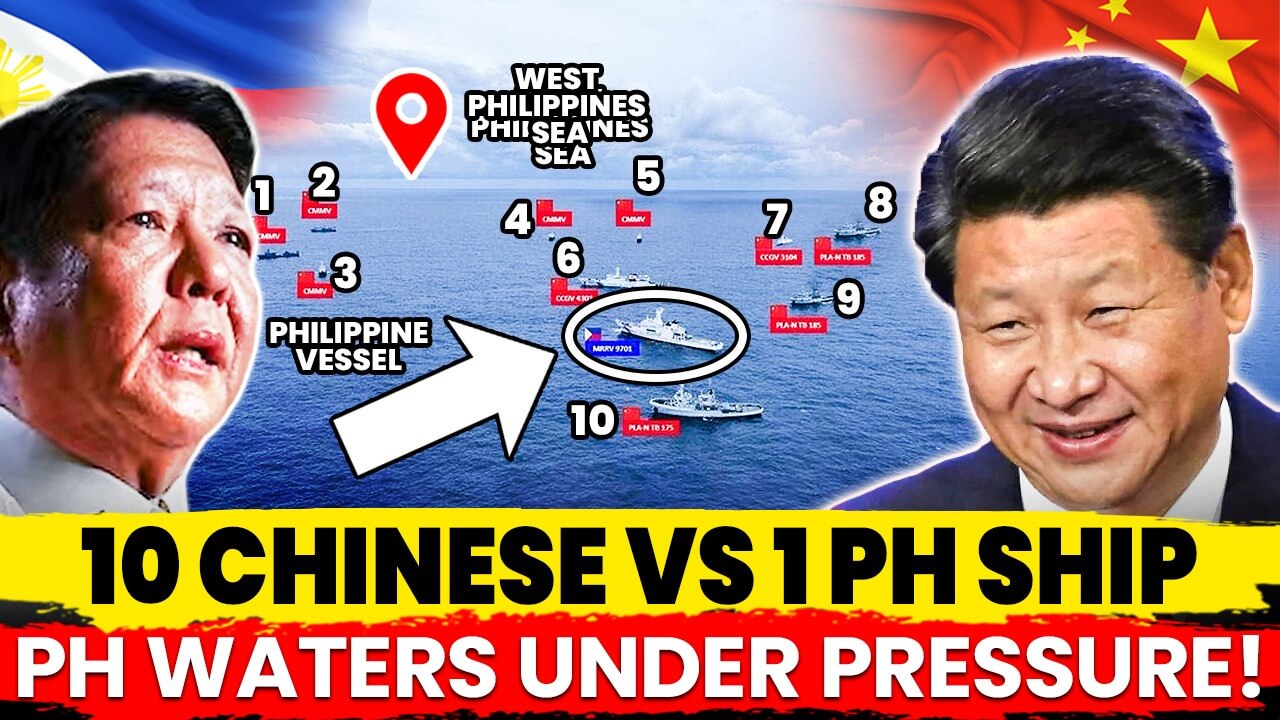In a significant display of military unity, the United States, Australia, Canada, and the Philippines conducted joint air and naval drills on Wednesday in the contested waters of the South China Sea. This move, aimed at promoting adherence to international law, comes as China continues to assert its expansive territorial claims in the region. Reacting to the multinational exercises, China conducted its own air and sea combat patrols on the same day. The Philippine military reported that three Chinese navy ships trailed the joint maneuvers off the western coast of the Philippines, although detailed interactions were not disclosed. Adm. Samuel Paparo, commander of the U.S. Indo-Pacific Command, along with top military officials from Australia, Canada, and the Philippines, issued a joint statement reaffirming their commitment to addressing common maritime challenges. They emphasized the importance of upholding international law and maintaining a rules-based order, highlighting the significance of the two-day exercises for ensuring unhindered navigation in the Indo-Pacific region.
China’s sweeping claims in the South China Sea, a crucial route for global trade and security, overlap with the territories of smaller coastal nations such as the Philippines and Vietnam. These claims have disrupted access to traditional fishing grounds and hindered oil and gas exploration activities within internationally recognized exclusive economic zones. The joint exercises included combined sea passage maneuvers, communications drills, and low-flying assault helicopters over naval ships. An anti-submarine warfare drill was also present, showcasing the enhanced cooperation and interoperability between the participating nations. Philippine navy spokesperson Rear Adm. Roy Trinidad clarified that the exercises were not directed against any specific country. Instead, they represented a collective effort to support a rules-based international order and ensure regional stability.
In response to the drills, China conducted joint sea and air combat patrols near the disputed Scarborough Shoal. While the Philippine military did not detect any Chinese combat patrols at the shoal, China’s Southern Theater Command acknowledged awareness of military activities in the South China Sea, asserting that they were under control. Adm. Paparo and his counterparts, Adm. David Johnston of the Australian Defense Force, Gen. Jennie Carignan of the Canadian Armed Forces, and Gen. Romeo Brawner Jr. of the Armed Forces of the Philippines, reiterated their nations’ commitment to freedom of navigation and overflight, and respect for maritime rights under international law.
Tensions between China and the Philippines have been particularly high, with several confrontations at disputed shoals since last year. A violent clash on June 17 at the Philippine-occupied Second Thomas Shoal heightened fears of a larger conflict involving the United States, a treaty ally of Manila. Most recently, China and the Philippines reached a temporary agreement to prevent further clashes. However, Chinese Foreign Minister Wang Yi has maintained that China will continue its military pressure on the Philippines. In a conversation with Philippine Foreign Secretary Enrique A. Manalo, Wang warned against the Philippines aligning with external forces to stir up trouble, emphasizing that China would defend its rights resolutely.
Wang’s comments followed incidents where the Chinese coast guard and maritime militia blocked Philippine supply missions, escalating the already tense situation. He accused the Philippines of changing its policy stance and provoking trouble at sea. The Philippine military reported incidents involving Chinese ships using water cannons and military-grade lasers against Filipino crews, leading to temporary blindness and dangerous confrontations. The U.S. is bound by a 1951 treaty to defend the Philippines in the event of an attack. This commitment has strengthened under the administration of President Ferdinand Marcos Jr., who has expressed repeated concerns over China’s increasing presence in the South China Sea. Recently, China released a new national map claiming most of the South China Sea, as well as disputed areas in India and Russia. This map has sparked protests from countries across the Asia-Pacific region. The map’s release follows a late August BRICS meeting and precedes high-level meetings of the Association of Southeast Asian Nations (ASEAN) and the Group of 20 (G20), signaling China’s unwavering stance on its territorial claims.
China’s Ministry of Natural Resources described the map as part of an ongoing effort to eliminate “problem maps,” aiming to provide standard maps and educate the public on proper map usage. The map includes the contentious nine-dash line, which demarcates China’s maritime borders, a claim that has been widely contested. In response, countries like India, Malaysia, Vietnam, Taiwan, Indonesia, and the Philippines have rejected China’s claims. The 2016 arbitration ruling by The Hague, which invalidated China’s claims, remains a point of contention. The Philippines continues to assert its rights based on this ruling, emphasizing its control over resources within its exclusive economic zone. China’s patrols near the Scarborough Shoal and the joint military exercises by the U.S., Australia, Canada, and the Philippines highlight the ongoing tensions and the complex geopolitical dynamics in the South China Sea.
However, Philippines’ military leaders have expressed that the recent drills are a testament to their resolve in maintaining a rules-based maritime order. They believe that cooperation with international allies is essential to counteract aggressive actions in the region. China’s latest actions, including the release of its controversial map and the patrols around Scarborough Shoal, are seen by many as attempts to assert control and challenge the established international order. These maneuvers have drawn sharp criticism from neighboring countries and international observers alike. The South China Sea remains a flashpoint for geopolitical tensions, with various stakeholders vying for control and influence. The recent exercises by the U.S., Australia, Canada, and the Philippines serve as a reminder of the region’s strategic importance and the ongoing struggle to maintain peace and stability. As the situation continues to evolve, diplomatic efforts and military readiness will play crucial roles in determining the future of the South China Sea. The international community will be closely monitoring developments, hoping for a resolution that respects international law and ensures the continued security of this vital maritime corridor.



